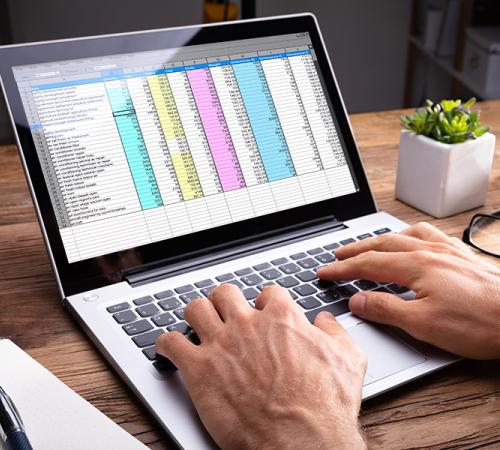

Explore how it works for both employers and staff in this Hiscox guide. We’ll cover the main PAYE meaning and what you need to know to keep your finances in order.
What does PAYE stand for?
PAYE stands for Pay As You Earn. While the term may sound complex, it’s a widely used way of collecting income tax and National Insurance from employees. In fact, it’s one of the two main methods to pay income tax, with self-assessment the other.
The roots of the PAYE tax system stretch back to 1944. Its aim was to boost efficiency, with workers paying tax at monthly intervals.
How does PAYE work?
Pay As You Earn works by deducting income tax and National Insurance from employee wages at source. That simply means it’s taken from their monthly salary before any money lands in their bank account.
The employer then passes the tax on to HM Revenue and Customs (HMRC), on the worker’s behalf [1].
Tax deductions can also be taken from people’s pension income through the PAYE system. Here, the pension provider will deduct what’s owed before any income is paid.
How is PAYE tax calculated?
A worker’s tax code and annual earnings are generally used to calculate their monthly HMRC PAYE payment.
Most employees will have a yearly personal allowance of £12,570. They won’t pay any income tax on earnings up to that level.
Above that threshold, they’ll pay a specific rate of tax based on their income:
Tax band |
Income thresholds |
Rate of tax |
|
Basic rate |
£12,571 to £50,270 |
20% |
|
Higher rate |
£50,271 to £150,000 |
40% |
|
Additional rate |
More than £150,000 |
45% |
Source: GOV.UK (external link)
Note: From April 2023, the higher rate tops out and the additional rate begins at the lower amount of £125,140 [2].
PAYE for employers
PAYE is an important element of payroll for employers. There are only a few circumstances where you won’t need to register for PAYE and make deductions. This is the case if none of your staff [3]:
- Earn £123 or more each week
- Receive expenses and benefits
- Have other jobs
- Receive pensions.
What payments can PAYE cover?
PAYE tax deductions apply to a range of payments made to staff. These include:
- Salaries and wages
- Bonus payments and tips
- Statutory sick pay
- Maternity pay.
Income tax and National Insurance are the main deductions to make before paying staff their monthly wages. But employers may also deduct pension contributions, student loan repayments, child maintenance payments and Payroll Giving donations [4].
Can I do PAYE myself?
You can oversee PAYE tax deductions yourself with the help of specialist payment software. To get set up, you’ll need to register with HMRC as an employer. You’ll also have to provide employee details.
Payroll for employers can prove complex. For that reason, many companies choose to operate PAYE with assistance from a third-party payroll provider.
How do I report employee deductions and pay HMRC?
Your payroll software should calculate the tax and National Insurance that need to be passed on to HMRC as PAYE payments. This includes any employer’s National Insurance contributions too.
You’re required to tell HMRC about all employee payments and deductions on or before your monthly payday. You can also send a separate report to claim reductions for things like statutory pay [5].
You’ll generally have to pay HMRC the balance of what you owe online by the 22nd of the current month. Penalties can apply if you fail to meet these payments [6].
What else should I report to HMRC?
Along with employee payments and deductions, you should let the tax authorities know about:
- New starters at your business.
- Any changes in people’s circumstances. Someone reaching the state pension age, for example.
Learn more about employer PAYE rules (external link)
PAYE for employees
Pay As You Earn can take the pressure off workers, since their employer automatically makes their tax deductions on their behalf. But as an employee, it’s still important to keep track of tax codes, payslips and P60 forms to ensure all the calculations are correct.
PAYE and your tax code
Your tax code directly influences the income tax that’s taken from your monthly wage. You should find it on your payslip, the HMRC app, and any official letters you receive.
Your code includes a combination of numbers and letters. 1257L is the most common. Each number and letter has a specific meaning, helping to show your tax-free income for the year.
For example, the letter ‘L’ tells your employer that you’re eligible for the standard tax-free personal allowance. Meanwhile, letters ‘M’ and ‘N’ relate to the Marriage Allowance. A full list is available from the Government (external link).
Checking PAYE on a payslip
Another way to keep track of PAYE is through your payslip. Your employer should provide you with this document each month. It typically lists your gross pay, take-home pay, and tax code.
Importantly, your payslip also lists any deductions from your gross salary. These may include your PAYE tax, National Insurance contributions, and pension or student loan payments. Speak to your employer, initially, if any deductions don’t look right.
Tracking PAYE tax through your P60
Along with a regular payslip, your employer should provide a P60 at the end of the tax year. This document offers a summary of your earnings and the overall tax you’ve paid.
It’s another useful way of tracking your PAYE tax and making sure everything is in order.
How does PAYE work for the self-employed?
Paying tax through PAYE isn’t normally an option for the self-employed. Instead, they typically use the self-assessment process to declare their tax.
However, in some cases, it may be possible to pay a self-assessment bill using a PAYE tax code. You’ll need to [7]:
- Owe less than £3,000.
- Be an existing taxpayer through PAYE. You might be an employee, for example.
- Have submitted an online tax return by 30 December. Or a paper one by 31 October.
Learn more about self-employed tax
Getting a firm financial footing
At first, the PAYE tax process may appear daunting to both employers and individual workers. But there’s a reason why this tried and tested system has been in place for so many decades.
As we’ve shown, you can get set up and keep track of things with a few simple steps. And getting your head around how it works should ultimately put your tax affairs on a much firmer footing.
References
- https://www.gov.uk/income-tax/how-you-pay-income-tax (external link)
- Income Tax Additional Rate Threshold from 6 April 2023 - GOV.UK (www.gov.uk)
- https://www.gov.uk/paye-for-employers (external link)
- https://www.gov.uk/running-payroll/deductions (external link)
- https://www.gov.uk/paye-for-employers (external link)
- https://www.gov.uk/running-payroll/paying-hmrc (external link)
- https://www.gov.uk/pay-self-assessment-tax-bill/through-your-tax-code (external link)
Disclaimer:
At Hiscox, we want to help your small business thrive. Our blog has many articles you may find relevant and useful as your business grows. But these articles aren’t professional advice. So, to find out more on a subject we cover here, please seek professional assistance.






